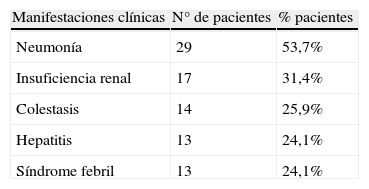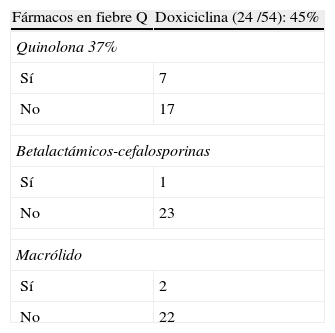Describir las características epidemiológicas y clínicas de la fiebre Q en una zona urbana de la Comunidad de Madrid.
Material y métodosEstudio observacional retrospectivo de cohorte de los casos diagnosticados de fiebre Q en un único centro desde enero de 2001 hasta diciembre de 2008. El diagnóstico de fiebre Q aguda se realizó mediante la detección de anticuerpos frente a antígenos fase II por técnica de enzyme-linked immunosorbent assay (ELISA) e inmunofluorescencia indirecta (IFI), en base a un título aislado ≥ 1/80 o cuando se demostró seroconversión o serorrefuerzo. El de fiebre Q crónica se realizó mediante anticuerpos frente antígenos fase I positivo si IgG ≥ 1/800.
ResultadosSe diagnosticaron 54 casos de fiebre Q en adultos. Cincuenta y un pacientes con fiebre Q aguda y 3 con fiebre Q crónica. Predominaron los varones de más de 50 años de edad y residentes en medio urbano. La clínica más frecuente fue la neumonía, la insuficiencia renal (33%), la hepatitis y el síndrome febril sin focalidad (25% ambas), con infección concomitante en el 37% de los casos. El seguimiento clínico y serológico en la mayoría de los pacientes fue inadecuado. La doxiciclina fue el tratamiento de mayor respuesta en enfermedad aguda, aunque en 10% con duración inadecuada.
To describe the epidemiological and clinical characteristics of Q fever in an urban zone of the Community of Madrid (Spain).
Material and methodsAn observational, retrospective study was performed of a cohort of cases diagnosed of Q fever within a single center in Madrid from January 2001 to December 2008. The diagnosis of acute Q fever was made by detection of antibodies against phase II antigen by Enzyme-Linked Immunosorbent Assay (ELISA) and indirect immunofluorescence (IFA), based on isolated titer ≥ 1/80 or when they showed seroconversion or seroreinforcement. Chronic Q fever was diagnosed using antibodies against phase I with a positive value if IgG ≥ 1/800.
ResultsA total of 54 cases of Q fever in adults were diagnosed; 51 patients had acute Q fever and only 3 chronic. There was a predominance of men over > 50years and from urban areas. The most frequent manifestation was pneumonia (54%), followed by renal failure (33%), hepatitis and fever without focality (25% in both), with concomitant infection in 37% of the cases. The clinical and serological monitoring in most of the patients were inadequate. The best response to treatment was with doxycycline in acute illness, although duration was inadequate in 10%.
Article
Diríjase desde aquí a la web de la >>>FESEMI<<< e inicie sesión mediante el formulario que se encuentra en la barra superior, pulsando sobre el candado.

Una vez autentificado, en la misma web de FESEMI, en el menú superior, elija la opción deseada.

>>>FESEMI<<<








